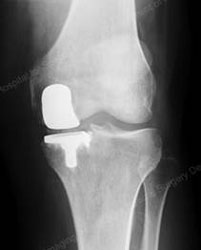Unicompartmental Knee Prosthesis as an option for treating knee osteoarthritis. (Part two)
Indications
It is said that the Unicompartmental Knee Prosthesis should be the first surgical procedure for osteoarthritis in young patients and the last in older patients.
The argument behind this statement is that in young patients, a unicompartmental replacement is simpler, heals faster, and has the same timetable when moving to total knee replacement as well as the other alternative which is tibial or femoral osteotomy.
 |
 |
Since the natural alignment of the bone components of the knee can only be restored and not changed, this procedure would be contraindicated in patients with a natural placement of more than 5° in varus or in valgus. In natural placements greater than these, this procedure would produce excessive load on the replaced compartment and likely early failure of the procedure.
The loads observed in prostheses are directly proportional to the patient's weight. Considering that the loads on a normal knee are four times body weight, and that in a normal knee 75% of this load passes through the medial compartment, in a patient with a high body mass index this could lead to early failures of the procedure.
In general, the following guidelines should be considered when planning a unicompartmental knee replacement:
- Age ≥ 55 years.
- Natural placement < 5° valgus or > 5° varus.
- The cruciate and collateral ligaments must be intact. (12, 13)
- In patients with a Body Mass Index ≥ 30, unicompartmental replacement is contraindicated.
- Opposite compartment:
- Meniscus: Must be intact, slightly fibrillated.
- Initial Chondrocalcinosis is acceptable.
- Articular cartilage: The opposite compartment must be intact.
- Superficial fibrillation is acceptable.
- Flexion Contracture must be < 15°.
- Total loss of patellofemoral cartilage is a contraindication.
- Inflammatory arthritis, rheumatoid arthritis, gout, and other arthritic processes should be considered as contraindications.
Contraindications
The contraindications for unicompartmental replacement are as follows:
- Inflammatory Arthropathy
- Previous HTO (High Tibial Osteotomy) resulting in hypercorrection.
- Sepsis
- Damage to the cruciate ligaments
- Medial or lateral subluxation (usually associated with a torn ACL)
- Deformities of the tibial or femoral axis
- Flexion contracture more than 15°
- Varus contracture more than 15° (in medial unicompartmental arthroplasty)
- Valgus contracture more than 20° (in lateral unicompartmental arthroplasty)
- Flexion less than 110°